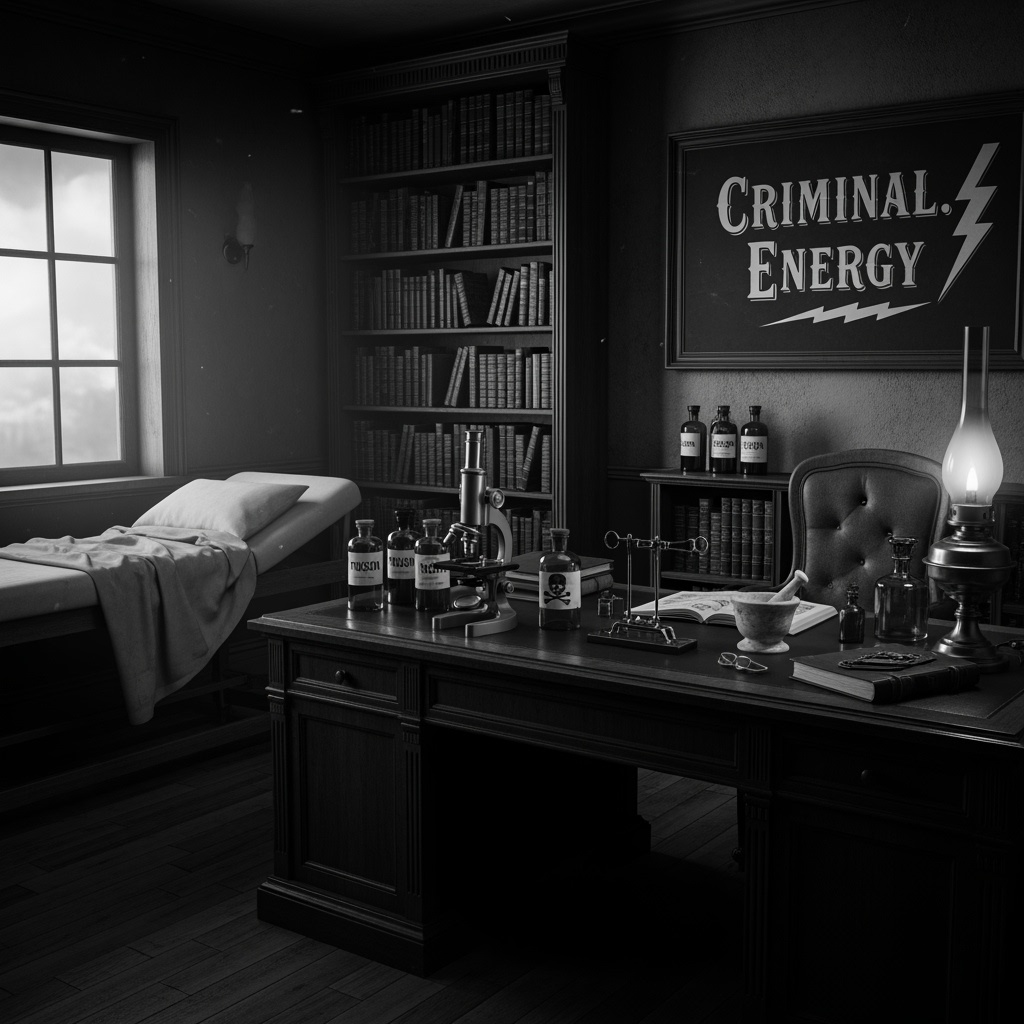Thomas Neill Cream, better known as the Lambeth Poisoner, was a Canadian doctor and serial killer who poisoned his victims with strychnine. Up to ten people in three countries fell victim to his murderous schemes – mainly women from the lower classes, prostitutes, and pregnant women seeking abortions. He was convicted of these murders and executed by hanging at Newgate Prison on November 15, 1892, by executioner James Billington. Billington spread the rumor that Thomas Neill Cream’s last words were, “I am Jack the Ripper!” However, official documents show that he was in prison in Illinois at the time of the Ripper murders. Born on May 27, 1850, in Glasgow, Cream grew up outside Quebec City, where his family had moved in 1854. He began his studies at Lachute Academy, which no longer exists, before studying medicine at McGill University in Montreal, where he received his doctorate in 1876. His dissertation was on chloroform. He initially practiced at St. Thomas’s Hospital Medical School in London and became a physician and surgeon in Edinburgh in 1878. He then returned to North America to work in a community that was in dire need of doctors. After a brief stay in Des Moines, he moved to London. In 1876, while staying in Waterloo, Cream met a woman named Flora Brooks. Their relationship resulted in a pregnancy that permanently ruined Flora’s health when Cream performed an unsuccessful abortion. He then fled to Montreal, but returned under pressure from Flora’s father and married her. Immediately after the wedding, he left his wife and moved to England to continue his medical studies. Flora never fully recovered and died of tuberculosis in 1877. In 1878, Cream returned to London and opened his practice there. He was charged with practicing medicine without a license under the Medical Act of Ontario and pleaded guilty. Nevertheless, his practice flourished. In 1879, Catharine Hutchinson Gardner, who was pregnant, was found dead in the toilets behind Cream’s practice at 204 Dundas Street. Not only had she been murdered with a chloroform-soaked handkerchief, but she had also been Cream’s mistress and was expecting his child. It turned out that Cream had refused to perform an abortion and had pressured her to accuse a local businessman of being the father of the child. According to Cream, Gardner had threatened to poison herself if he did not help her and had written a fake letter implicating the businessman. Despite overwhelming evidence against Cream, the police took no further action and the case remained unsolved. Shortly after this episode, Cream opened another practice in a troubled neighborhood in Chicago, offering illegal abortions to prostitutes. In August 1880, he came under the scrutiny of investigators after the death of Mary Anne Faulkner, but due to lack of evidence, he escaped conviction. In December 1880, Miss Stack died after treatment by Cream, who then blackmailed the pharmacist who had filled the prescription. In April 1881, Alice Montgomery died of strychnine poisoning after attempting an abortion in a house one block away from Cream’s practice. The case was classified as murder but never solved. The location, time, and method made Cream the prime suspect. On July 14, 1881, Daniel Stott died of strychnine poisoning at his home in Boone County after Cream gave him a supposed cure for epilepsy. The death was considered natural, and Cream blamed the pharmacist who allegedly supplied him with the wrong medication. Cream was arrested along with Julia Abbey Stott, his mistress and wife of the murdered Daniel Stott. She tried to shift the blame onto Cream to avoid imprisonment, and Cream was eventually convicted of murder. He was sentenced to life imprisonment and was interned at Joliet Prison. Daniel Stott’s family erected a tombstone that reads: “Daniel Stott, died June 12, 1881, aged 61, poisoned by his wife and Dr. Cream.” In 1891, Cream was released from prison. Governor Joseph Fifer had commuted his sentence after Cream’s brother pleaded for mercy and possibly bribed the authorities. With the inheritance from his father, who had died in 1887, Cream crossed the Atlantic and returned to England. He landed in Liverpool on October 1, 1891, three years after the Jack the Ripper murders. He moved to London and lived at 103 Lambeth Palace Road. At that time, Lambeth was characterized by poverty, petty crime, and prostitution. On October 13, 1891, 19-year-old prostitute Ellen “Nellie” Donworth received two letters from Cream and agreed to meet him. She fell seriously ill and died of strychnine poisoning. During the police investigation, Cream wrote to the coroner under the pseudonym A. O’Brien, offering to name the murderer in exchange for a reward of £300,000. He also wrote to W. F. D. Smith, the owner of W. H. Smith bookshops, accusing him of the murder and demanding hush money. On October 20, Cream met 27-year-old prostitute Matilda Clover and gave her four pills to take before going to bed. Later that night, she suffered violent convulsions and died two hours later. It was assumed that she had died of alcohol withdrawal. Cream, under the name Mr. Malone, wrote a blackmail note to the renowned physician William Broadbent, demanding £25,000 for his silence. Broadbent informed Scotland Yard in order to trap the blackmailer, but no one was caught. On April 2, 1892, Cream returned to London after a trip to Canada and met Louise Harvey, a prostitute. He gave her two pills and urged her to take them immediately. Suspicious, she pretended to swallow them and secretly threw the pills into the Thames. On April 11, Cream met prostitutes Alice Marsh and Emma Shrivell. He spent the night with them and gave them three pills and a can of salmon before leaving. Both women later died of strychnine poisoning. Cream’s blackmail letters drew attention to him. The police were quickly able to establish the innocence of the accused and noticed something suspicious: the unknown author made a reference to the death of Matilda Clover, which had been classified as a natural cause of death. The police soon realized that their unknown accuser was a serial killer, now known as the Lambeth Poisoner. Shortly thereafter, Cream met an American police officer who was visiting London. The officer told a British colleague about Cream’s detailed knowledge of the murders, which aroused suspicion. Scotland Yard monitored Cream and quickly discovered his connection to the prostitutes and his criminal past in North America. On June 3, 1892, Cream was arrested. On October 17, 1892, Cream’s trial began and lasted until October 21. After only 12 minutes of deliberation, he was found guilty on all counts and sentenced to death by Judge Henry Hawkins. On November 15, less than a month after his conviction, he was hanged by James Billington at Newgate Prison. In accordance with tradition, his body was buried on the prison grounds on the same day and later reburied in London City Cemetery. Today, he lies anonymously in section 339. The reasons for Cream’s murders are unknown. He is said to have been sadistic, as he enjoyed the deaths of his victims. At the same time, he was greedy for money, as his repeated attempts at blackmail show. He murdered Daniel Stott in the hope that his wealthy widow would share her inheritance with him. In addition to the five confirmed murders, Cream is suspected of having killed his wife Flora Brooks and at least four other women. However, the true number of his murders will probably remain a mystery forever. I hope you enjoy my photos of Glasgow.
The sinister doctor: The sinister legacy of Thomas Neill Cream, one of the first serial killers
ByIsabella Mueller
Sep 12, 2025
By Isabella Mueller
Welcome to my journey through creativity and discovery! My name is Isabella Mueller, and I invite you to explore the fascinating creative universes I create through my blogs. Since 2020, I have been dedicating my passion to telling captivating stories that are mysterious, historical, and emotional. My goal is not only to entertain, but also to inspire reflection and awaken the spirit of discovery in each of us. At isabellas.blog, the suspense of crime stories is combined with exciting travel tips. Imagine wandering through the picturesque streets of a new city, uncovering dark secrets hidden in the shadows of its history. Every piece on my blog is designed to make the heart of every crime fiction fan beat faster while sparking curiosity about unknown places. Here, you are invited to experience the thrill of the unknown and the beauty of our world—a perfect combination for all adventure seekers! My second blog, akteq.com, is all about true, unsolved crime stories. Under the motto “akteQ: Cold Case Stories,” I reveal the eerie and often tragic stories behind unsolved cases. Together, we can explore the mysteries of the past and delve deep into the human psyche. What really happened? Who were the people behind these mysterious events? In this blog, I invite you to ask questions and find the answers that often remain hidden in the dark. You can find another exciting chapter in my blogging career at thecastles.org. Here, I embark on an enchanting journey through the history of castles and palaces. Pause for a moment as you discover the stories hidden within the walls of these ancient structures. “Explore the enchantment, discover the history – your journey begins at thecastles.org!” These words are more than just a slogan; they are an invitation to anyone who wants to combine history and magic. Be inspired by the impressive stories and the fascination of bygone eras! But that's not all! At kripo.org, you'll find a comprehensive online magazine for real criminal cases. Immerse yourself in the world of crime, learn about the real stories behind the headlines and the people who are involved in solving them. With criminal.energy, I take you on a journey through the gripping stories of true crimes in which villains are hunted, caught, and convicted. The search for justice and the confrontation with the unknown are at the center of it all. TrueCrime Blog 187.news takes you into the depths of crime. And for those who want to travel the world, wanderlust.plus offers the opportunity to explore the world, one adventure at a time. It's all about the love of exploration and the joy of discovering new cultures and landscapes. Finally, truecrime.ch invites you to discover the dark side of Switzerland and Europe: true crimes, true stories. Let's discover together the stories that shape the world around us. I look forward to accompanying you on this exciting journey and hope you will share many unforgettable moments with me!
